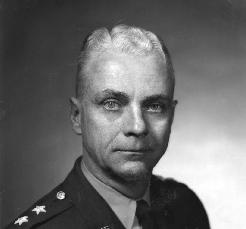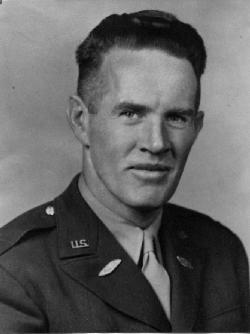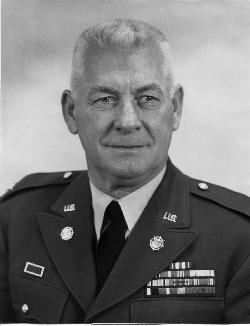JAMES BERNARD QUILL
 James
Bernard Quill was born in Milwaukee, May 15, 1905. He was graduated from the U.S. Military Academy in 1929, the
troop officers' course at the Cavalry School in 1934, the advanced equitation course in 1937, the Command and General
Staff College in 1943 and the Industrial College of the Armed Forces in 1952.
James
Bernard Quill was born in Milwaukee, May 15, 1905. He was graduated from the U.S. Military Academy in 1929, the
troop officers' course at the Cavalry School in 1934, the advanced equitation course in 1937, the Command and General
Staff College in 1943 and the Industrial College of the Armed Forces in 1952.
He served as a platoon leader and troop commander before joining the 6th Armored
Division as the original commanding officer of the 86th Armored Reconnaissance Battalion in February 1942. He left
the 86th in June 1943 to serve as plans and training officer of the II Armored Corps and became deputy chief of
staff of the XVIII Airborne Corps (formerly the II Armored Corps) in the European Theater of Operations before
he was named assistant to the assistant chief of staff, G-l, Army Ground Forces.
Following World War II Gen. Quill completed a year of graduate study at the
University of Minnesota and served as chief of the personnel management department, school of personnel, at the
Command and General Staff College before assuming command of the 14th Armored Cavalry Regiment of the U. S. Constabulary
in Europe in 1949. Two years later he was named executive officer of the G-2 section, Seventh Army.
Gen. Quill returned to the United States in August 1951 to attend the Industrial
College and on completion of that course he served first as organization control officer and then as assistant
chief, Management Division, Office of the Comptroller of the Army.
In October 1953 he assumed command of the 1st Armored Division's Reserve Command
and four months later he became CO of Combat Command A.
His next assignment was assistant comptroller of the Army from January 1956
until January 1959, with promotion to major general in November 1956. He was commanding general of the 4th Armored
Division from February 1959 to April 1960, deputy chief of staff, Operations and Intelligence, FFCENT, until November
1961 and deputy commandant of the Industrial College from December 1961 until his retirement on August 1, 1963.
Gen. Quill's decorations include the Bronze Star Medal, EAME Campaign Medal,
Commendation Ribbon with Metal Pendant, American Defense Service Ribbon, American Campaign Medal, World War II
Victory Medal, Army of Occupation Medal (Germany), National Defense Service Medal, Korean Service Medal and United
Nations Service Medal.
General Quill died March 27, 1986. Survivors were his widow, the former Louise
Hosack, son James B. Quill Jr. and daughter Mrs. Barbara Ann Johnson.
ALBERT EVERETT HARRIS
 Albert
Everett Harris, the son of a pioneer Nevada family, was born in Chapman, California, July 3, 1903. A graduate of
Reno High School, he withdrew from the University of Nevada College of Engineering in his senior year to enter
the U.S. Military Academy, from which he was graduated in 1930.
Albert
Everett Harris, the son of a pioneer Nevada family, was born in Chapman, California, July 3, 1903. A graduate of
Reno High School, he withdrew from the University of Nevada College of Engineering in his senior year to enter
the U.S. Military Academy, from which he was graduated in 1930.
He immediately married the former Katharine Ryan of Reno and was commissioned
in the Cavalry, his favorite branch of service.
His first tour of duty was at the Presidio of Monterey and, after attending
the Cavalry School and serving as an instructor at West Point, he returned to the Presidio with the 11th Cavalry.
With the advent of World War II he was assigned to the 2nd Armored Division at Ft. Benning, Ga., and from there
to the brand-new 6th Armored Division at Ft. Knox, Ky., where he became executive officer and, for a time, acting
adjutant of the fledgling 86th Armored Reconnaissance Battalion in the rank of captain.
Capt. Harris moved to Camp Chaffee, Ark., with the 86th, was promoted to major,
and subsequently left the unit to become executive officer of the 69th Armored Regiment with promotion to lieutenant
colonel. After attending Command and General Staff College he returned to the 86th on September 16, 1943 to succeed
Col. Quill as battalion commander.
Col. Harris therefore was already on the scene when the unit was redesignated
as the 86th Cavalry Reconnaissance Squadron Mechanized. He commanded the squadron through the remainder of its
training in the United States and England and through its baptism of fire in Normandy and Brittany before he was
given command of Reserve Command and later Combat Command A, attaining the rank of colonel.
Following World War II Col. Harris made a brief visit to Reno and then returned
with his wife and daughters Kress and Maizie to Germany where he served for two years as provost marshal of constabulary
in the Army of Occupation.
He returned to the U.S. for a tour of duty at Ft. Knox before taking over
as director of instruction at the Command and General Staff College for three years. In July 1952 he was assigned
to the Army Language School at the Presidio for a year in preparation for appointment as Army attaché at
Ankara, Turkey. He was stricken by a heart attack on the golf course and died on December 6. Fittingly, he was
buried at the Presidio, his first station and his last.
Col. Harris' decorations include the Legion of Merit, Silver Star Medal, Bronze
Star Medal with OLC, American Commendation Ribbon with OLC and the French Croix de Guerre with Palm.
Harry Cockrell Brindle
 Harry
Cockrell Brindle was born in Martinsburg, W. Va., on November 23, 1907. He attended Massanutten Military Academy
in Woodstock, Va., and Rutgers University, where he played freshman football and baseball, and was graduated from
Marshall College in Huntington, W. Va., where he was a member of the varsity football and baseball teams.
Harry
Cockrell Brindle was born in Martinsburg, W. Va., on November 23, 1907. He attended Massanutten Military Academy
in Woodstock, Va., and Rutgers University, where he played freshman football and baseball, and was graduated from
Marshall College in Huntington, W. Va., where he was a member of the varsity football and baseball teams.
A member of the ROTC, he received a commission in the Officers Reserve Corps.
Ordered to active duty February 10, 1941, he was assigned to the original cadre for the Armored Force Replacement
Training Center at Ft. Knox, Ky. After attending the Armor School he returned to the AFRTC as a special staff officer,
subsequently joining the cadre for the 6th Armored Division. He was the original commanding officer of Company
E in the 69th Armored Regiment as a first lieutenant and captain and was appointed Regimental S-3 with promotion
to major. With the introduction of a new Table of Organization to the division, he was transferred to the 86th
Cavalry Reconnaissance Squadron Mechanized as S-3 on September 20, 1943. He succeeded Col. Harris as squadron CO
on September 12, 1944 and subsequently was promoted to lieutenant colonel, commanding the 86th through the remainder
of the war.
Following World War II Col. Brindle was assigned as head of the Mechanized
Cavalry Reconnaissance Section of the Armored School Tactics Department at Ft. Knox and as head of the Mechanized
Cavalry Section on the University of Georgia military staff prior to attending the Advanced Officers Course at
the Army's Transportation School.
His service with the Transportation Corps included stints as executive officer
of the Port of Whittier, Alaska; CO at Camp Leroy Johnson in New Orleans; Transportation officer and commander
of Army troops, Thule, Greenland, in the SUNAC-Blue Jay Operation in 1951-52; deputy chief of staff, Hq, San Francisco
Port of Embarkation, Ft. Mason Calif.; transportation advisor, Hq, Army of the Republic of Korea Advisory Group,
Tague, Korea; transportation officer, Hq, Eighth U. S. Army (Fwd); CO, Port of Kobe, Japan; executive officer,
Military Detachment, Hq, First U.S. Army, G-4 Section, with duty with the Hungarian Relief Program, Camp Kilmer,
N.J.; chief, Supply and Maintenance Section, Hq, First U.S. Army, G-4 Section, and deputy corps commander, Hq,
U.S. Army X Corps, Ft. Lawson, Wash.
Col. Brindle retired from the Army on February 1, 1963. His decorations include
the Silver Star Medal, Bronze Star Medal, Army Commendation Ribbon with Metal Pendant, Army of Occupation Medal
(Germany), American Campaign Medal, EAME Campaign Medal, World War II Victory Medal, American Defense Service Medal,
National Defense Service Medal and French Croix de Guerre with Etoile de Vermeil.
Col. Brindle died in Tampa, Fla., November 30, 1978 and was buried in Arlington
National Cemetery. He is survived by his widow, the former Sara Louise Gibson, and three children, Harry T. Brindle,
Sally Brindle Granston and Carolyn Brindle Hunter.

Go to "The Introduction" or "Table of Contents"
page.
 James
Bernard Quill was born in Milwaukee, May 15, 1905. He was graduated from the U.S. Military Academy in 1929, the
troop officers' course at the Cavalry School in 1934, the advanced equitation course in 1937, the Command and General
Staff College in 1943 and the Industrial College of the Armed Forces in 1952.
James
Bernard Quill was born in Milwaukee, May 15, 1905. He was graduated from the U.S. Military Academy in 1929, the
troop officers' course at the Cavalry School in 1934, the advanced equitation course in 1937, the Command and General
Staff College in 1943 and the Industrial College of the Armed Forces in 1952. Albert
Everett Harris, the son of a pioneer Nevada family, was born in Chapman, California, July 3, 1903. A graduate of
Reno High School, he withdrew from the University of Nevada College of Engineering in his senior year to enter
the U.S. Military Academy, from which he was graduated in 1930.
Albert
Everett Harris, the son of a pioneer Nevada family, was born in Chapman, California, July 3, 1903. A graduate of
Reno High School, he withdrew from the University of Nevada College of Engineering in his senior year to enter
the U.S. Military Academy, from which he was graduated in 1930. Harry
Cockrell Brindle was born in Martinsburg, W. Va., on November 23, 1907. He attended Massanutten Military Academy
in Woodstock, Va., and Rutgers University, where he played freshman football and baseball, and was graduated from
Marshall College in Huntington, W. Va., where he was a member of the varsity football and baseball teams.
Harry
Cockrell Brindle was born in Martinsburg, W. Va., on November 23, 1907. He attended Massanutten Military Academy
in Woodstock, Va., and Rutgers University, where he played freshman football and baseball, and was graduated from
Marshall College in Huntington, W. Va., where he was a member of the varsity football and baseball teams.